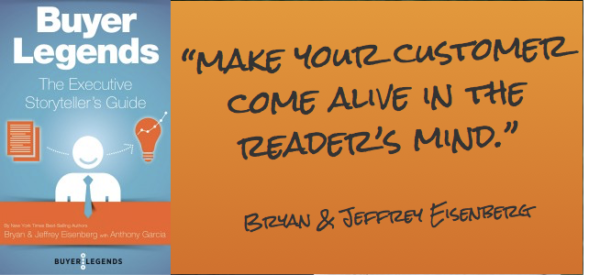
What’s the best way to see your customers as they really, truly are? By inventing some of them!
As my seven-year-old daughter likes to say: “Not. Even. Kidding.”
Remember: The subject of your marketing should not be you or your company or even your product or service. The subject of your marketing should be your customer!
So, rather than some ethereal, mythical, abject “customer,” let’s make this person (or these people) real.

I’m going to quote directly from the guys who literally wrote the book on customer journeys, my mentors, friends, and authors of the Foreword to our upcoming book, Jeffrey and Bryan Eisenberg. In Buyer Legends: The Executive Storyteller’s Guide, they write:
Start with basic demographics, which should be representative of your typical customers, when possible. If you have a broad base of customers, don’t worry about representing everyone for now, simply select a common “type” or segment to get you started. Begin to list the traits of your customer and be sure to give him or her a name. It helps to be specific in your list of traits, as you want to end up with something that sounds like a real individual rather than a generalized stand-in. Start with a name and then give them an exact age, a career, a title, even an income if it is relevant to the story. The goal is to make your customer come alive in the reader’s mind.
Click here to download a very basic persona development form from our forthcoming book, The First Order of Business.

You Have Everything You Need To Create More
We’d all like to duplicate our favorite customers, wouldn’t we? Well, to attract them, we need to communicate directly to people just like them. Who are your company’s favorite customers? Ask your employees about them! Go through their answers and look for different subsets of customers.
Airlines, for examples, provide very different experiences (or should) for the frequent-flying business travelers and families traveling to Disney. Hotels cater to business travelers differently than conference bookers.
We’ve written previously about mapping your customer experience and tuning your customer experience. Then, work with your team, to create additional personas for which you’re going to do the same. Give them names. Go to a stock photo site and give them headshots. Share them with your company. Walk them through (or have them walk you through) the ideal scenarios to turn them into customers for life.
As the Eisenbergs said, simply “make your customer come alive in the reader’s mind.”
Those readers may also be viewers and listeners. Transitioning them from make-believe to real life begins by your company first seeing them alive, then soon, your potential customer—when they come into contact with your marketing touchpoints—will see themselves clearly.
Speaking of “clearly,” Best Buy clearly could have worked harder to develop at least one additional persona (if they ever developed any at all). They would have saved me the time and energy I’ve expended these past few years telling a story about… well… read it for yourself.


Leave a Reply